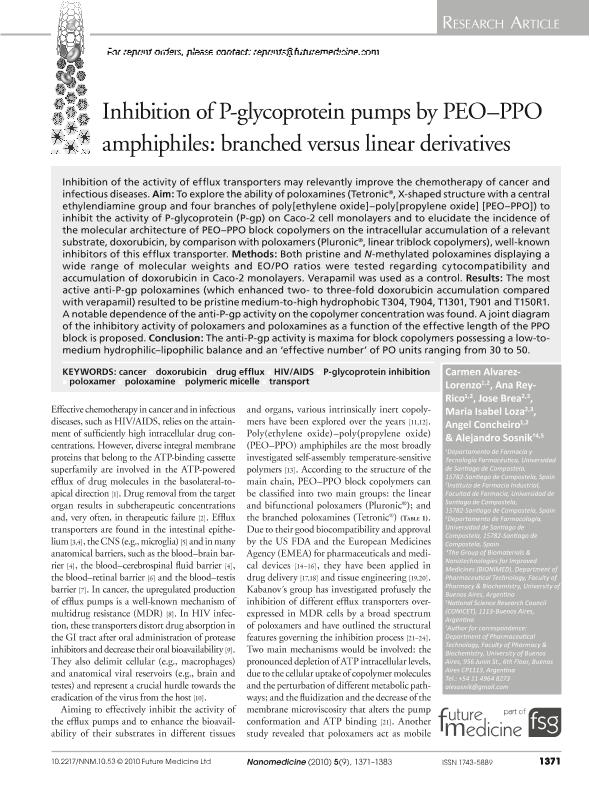Mostrar el registro sencillo del ítem
dc.contributor.author
Alvarez Lorenzo, Carmen
dc.contributor.author
Rey Rico, Ana
dc.contributor.author
Brea, José
dc.contributor.author
Loza, Maria Isabel
dc.contributor.author
Concheiro, Ángel
dc.contributor.author
Sosnik, Alejandro Dario

dc.date.available
2017-03-29T18:37:50Z
dc.date.issued
2010-12
dc.identifier.citation
Alvarez Lorenzo, Carmen; Rey Rico, Ana; Brea, José; Loza, Maria Isabel; Concheiro, Ángel; et al.; Inhibition of P-glycoprotein pumps by PEO–PPO amphiphiles: branched versus linear derivatives; Future Medicine; Nanomedicine; 5; 9; 12-2010; 1371-1383
dc.identifier.issn
1743-5889
dc.identifier.uri
http://hdl.handle.net/11336/14453
dc.description.abstract
Inhibition of the activity of efflux transporters may relevantly improve the chemotherapy of cancer and infectious diseases. Aim: To explore the ability of poloxamines (Tetronic®, X-shaped structure with a central ethylendiamine group and four branches of poly[ethylene oxide]–poly[propylene oxide] [PEO–PPO]) to inhibit the activity of P-glycoprotein (P-gp) on Caco-2 cell monolayers and to elucidate the incidence of the molecular architecture of PEO–PPO block copolymers on the intracellular accumulation of a relevant substrate, doxorubicin, by comparison with poloxamers (Pluronic®, linear triblock copolymers), well-known inhibitors of this efflux transporter. Methods: Both pristine and N-methylated poloxamines displaying a wide range of molecular weights and EO/PO ratios were tested regarding cytocompatibility and accumulation of doxorubicin in Caco-2 monolayers. Verapamil was used as a control. Results: The most active anti-P-gp poloxamines (which enhanced two- to three-fold doxorubicin accumulation compared with verapamil) resulted to be pristine medium-to-high hydrophobic T304, T904, T1301, T901 and T150R1. A notable dependence of the anti-P-gp activity on the copolymer concentration was found. A joint diagram of the inhibitory activity of poloxamers and poloxamines as a function of the effective length of the PPO block is proposed. Conclusion: The anti-P-gp activity is maxima for block copolymers possessing a low-to-medium hydrophilic–lipophilic balance and an ‘effective number’ of PO units ranging from 30 to 50.
dc.format
application/pdf
dc.language.iso
eng
dc.publisher
Future Medicine

dc.rights
info:eu-repo/semantics/openAccess
dc.rights.uri
https://creativecommons.org/licenses/by-nc-sa/2.5/ar/
dc.subject
Cancer
dc.subject
Doxorubicin
dc.subject
Drug Efflux
dc.subject
P-Glycoprotein Inhibition
dc.subject
Poloxamer
dc.subject
Poloxamine
dc.subject
Polymeric Micelle
dc.subject
Transport
dc.subject.classification
Otras Nanotecnología

dc.subject.classification
Nanotecnología

dc.subject.classification
INGENIERÍAS Y TECNOLOGÍAS

dc.title
Inhibition of P-glycoprotein pumps by PEO–PPO amphiphiles: branched versus linear derivatives
dc.type
info:eu-repo/semantics/article
dc.type
info:ar-repo/semantics/artículo
dc.type
info:eu-repo/semantics/publishedVersion
dc.date.updated
2017-03-21T20:12:46Z
dc.journal.volume
5
dc.journal.number
9
dc.journal.pagination
1371-1383
dc.journal.pais
Reino Unido

dc.journal.ciudad
Londres
dc.description.fil
Fil: Alvarez Lorenzo, Carmen. Universidad de Santiago de Compostela; España
dc.description.fil
Fil: Rey Rico, Ana. Universidad de Santiago de Compostela; España
dc.description.fil
Fil: Brea, José. Universidad de Santiago de Compostela; España
dc.description.fil
Fil: Loza, Maria Isabel. Universidad de Santiago de Compostela; España
dc.description.fil
Fil: Concheiro, Ángel. Universidad de Santiago de Compostela; España
dc.description.fil
Fil: Sosnik, Alejandro Dario. Consejo Nacional de Investigaciones Científicas y Técnicas; Argentina. Universidad de Buenos Aires. Facultad de Farmacia y Bioquímica. Departamento de Tecnología Farmacéutica; Argentina
dc.journal.title
Nanomedicine

dc.relation.alternativeid
info:eu-repo/semantics/altIdentifier/url/http://www.futuremedicine.com/doi/full/10.2217/nnm.10.53
dc.relation.alternativeid
info:eu-repo/semantics/altIdentifier/doi/http://dx.doi.org/10.2217/nnm.10.53
Archivos asociados
